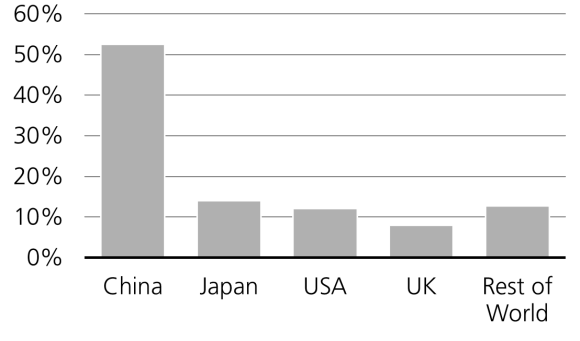First steps to investing: a beginner’s guide
Never invested? No problem. We give you valuable tips on how to get started. Let’s go!

We see a multi-asset approach to investing in China as an optimal way to capitalize from new policy catalysts—while staying diversified and protected against downside risk.
Highlights
Headwinds to tailwinds
2023 is a year in which we expect China will reassert itself as the engine of global economic activity. Chinese policy has evolved in a much more growth and market-friendly direction. As the zero COVID policy ended, we are confident that a comprehensive, durable economic reopening with staying power has started, underpinning the return of consumer spending to pre-pandemic norms.
In addition, prior attempts to rein in excesses in real estate are being replaced with a more nuanced set of measures designed to support both supply and demand and promote stability in the overall sector. And the regulatory campaign on Chinese technology and internet platform companies appears to have run its course. A more cooperative relationship with the government for these companies makes a critical catalyst for equity multiples to re-rate higher, in our view.
A wide range of opportunities
We believe a multi-asset approach to investing in China is optimal because it gives investors comprehensive exposure to this multifaceted suite of policy changes.
Onshore equities are heavily weighted towards domestic financial and industrial companies, which are well-positioned to benefit from a generally improving economy. The end of the technology regulatory campaign disproportionately helps larger internet platform companies, which are well-represented in offshore equity indexes, by removing a critical overhang on valuations.
Investors can also gain access to the prospective stabilization in real estate through Chinese high yield bonds. We are cognizant that Chinese developers face structural challenges. But investors are being well-compensated for assuming such risk, in our view, with spreads at levels rarely seen outside of times of crisis. We expect a controlled deleveraging in real estate going forward, given the importance of the sector to the economy and household net worth.
Meanwhile, Chinese sovereign bonds help insulate investors from any country-specific concerns that may weigh on domestic risk assets. Indeed, they demonstrated this capability recently, faring much better than US and European fixed income indexes during the period of Chinese risk asset underperformance that started in early 2021.
China’s demographic challenges, which are likely to contribute to a slower rate of economic growth over the medium term, are well-documented. What is less appreciated, in our view, is how much this dynamic is also boosting the demand for asset management services and flows into financial markets. We anticipate that financial assets will continue to gain share from real estate as a preferred savings vehicle within China in accordance with the mantra that “housing is for living, not for speculating,” Through mid-2022, the five-year average growth in assets under management in China has far outstripped that of other major countries, rising in excess of 50%.

A portfolio enhancer
Chinese equities are projected to post annual geometric returns 1.7 percentage points higher than developed-market stocks over the next five years, thanks to relatively less expensive valuations and stronger growth.
Geometric returns take into account the correlations between different asset classes as well as the impact of interest compounding over longer time horizons. Geometric returns are considered a more meaningful measure of returns than arithmetic returns.

Importantly, Chinese assets also display a low correlation to developed market stocks and bonds. This lack of co-movement is particularly attractive in 2023, as Chinese assets have far more policy tailwinds compared to other countries. There is a potential for a more asynchronous global economic cycle as Chinese activity accelerates while the rest of the world decelerates.

Our five-year capital market expectations suggest that adding exposure to Chinese stocks and bonds to a global diversified portfolio produces incremental improvements in both returns and the Sharpe ratio. The improvements may seem modest, but this is a function of position size in relation to the overall portfolio.
Title | Title | Global 60/40 with 10% China exposure | Global 60/40 with 10% China exposure | ||
|---|---|---|---|---|---|
Title | 5Y geometric annualized return | 6.9% | Global 60/40 with 10% China exposure | 7.1% | |
Title | Sharpe Ratio | 0.33 | Global 60/40 with 10% China exposure | 0.34 |
In addition, Chinese government bonds retain important hedging properties when paired with domestic risk assets. On a going-forward basis, our five-year capital market expectations also show that the inclusion of a 20% allocation to government bonds would raise the Sharpe ratio relative to a portfolio composed fully of Chinese equities, with a modestly lower profile for both risk and returns.
New policy catalysts present new opportunities and a multi-asset solution that includes stocks, credit and government bonds could be the right approach to invest in China’s accelerated reopening—as well as the long-term China growth story.
Never invested? No problem. We give you valuable tips on how to get started. Let’s go!
Creating a budget is simple: once you know what you should look for, you can easily track your monthly expenses and see where you could save. Take control of your budget with this template.
Fill in an inquiry form and leave your details – we’ll be back in touch.
Meet the members of the team responsible for UBS Asset Management’s strategic direction.